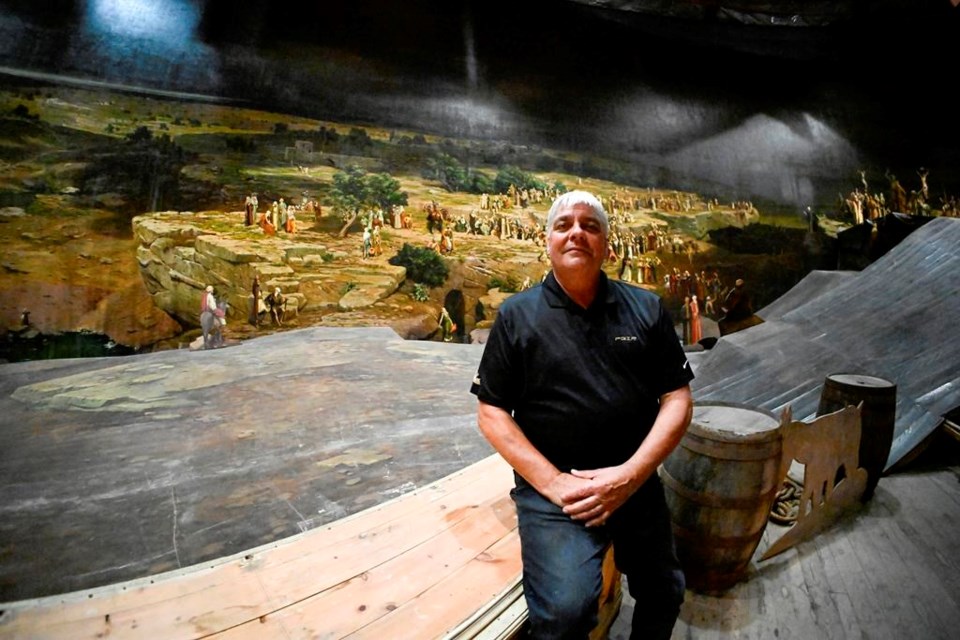MONTREAL — The last cyclorama in Canada has been hidden from public view since it closed in 2018, but a small group of people are hoping to revive the unique Quebec-based attraction.
The Cyclorama of Jerusalem — a 360-degree painting 14 metres high by 110 metres around — has sat across the street from the renowned basilica in Ste-Anne-de-Beaupré, northeast of Quebec City, since 1895. The panorama depicts what the city of Jerusalem may have looked like at the time of the Crucifixion of Jesus.
But the fate of the attraction has followed the waning interest in religion among Quebecers, and in 2018 the local family that owns the site closed it because it was unprofitable and needed repair. Attempts to sell it were unsuccessful. But the following year, the Quebec government declared the cyclorama a heritage property.
Ste-Anne-de-Beaupré resident Annie Lévesque is among a group of volunteers working to find a way to have the massive panoramic painting opened to the public once more.
"It's the only cyclorama left in Canada, so I strongly hope that the different stakeholders realize the importance of safeguarding and ensuring the continuity of a site like this," Lévesque said.
Pierre Blouin, whose family has owned and operated the religious attraction since 1949, still hopes to sell the property. He penned a lengthy piece in Reader's Digest this summer seeking new blood to run the once-popular landmark.
Lévesque, a local gallery owner, was recruited by the Blouin family because of her background in cultural development. A reopened site would be more attractive to potential buyers, she said, adding that she is helping the family hunt for an agent.
"It's difficult to sell a company when it's closed," Lévesque said.
Jérémie Germain's involvement in the group was by happenstance. While visiting an art gallery owned by Lévesque in 2021, he noticed the cyclorama through the window but had no idea what it was.
"It's a magnificent piece of art, you know, truly I was astonished that … this thing was sitting there in the dark, so to speak," said Germain, who has a background in e-commerce and computer science.
After chatting with Lévesque about the religious artwork he joined her group, which consists of a few dozen people from different walks of life — professionals, lawyers, historians and enthusiasts — all committed to reopening it.
The artwork is in good condition and has been visited by historians and experts in recent years. The group reopened the gift shop in Easter 2022 to sell some of its wares to fund needed repairs. There's no firm timetable for reopening, Lévesque said.
The cyclorama was given heritage status in August 2019 in an effort to protect its artistic, historic and architectural value.
Quebec's heritage directory says the painting is the work of Oliver Dennett Grover and Charles Abel Corwin, assisted by others, and produced around 1887 or 1888 in the United States. It was then put on display in Montreal until 1895, when it was sold and moved by boat to Quebec City. The design was inspired by a panorama painted by German artist Bruno Piglhein, which served as a model for a number of panoramic works with the similar Crucifixion scenario.
Quebec's Culture Department obtained a court order in March 2022 for emergency roof work that was completed in February after the owners were unable to pay.
"The (Department) intervened in an exceptional manner to allow urgent consolidation work to be carried out on the roof, which had to be done to ensure the integrity of the classified property," the culture department said in a statement. The government took out a mortgage that the owners will be responsible for reimbursing.
Lévesque and Germain's group is trying to find ways to drum up interest in the artwork and make it more appealing to newer generations. Germain said people today may not appreciate the sheer size of the cyclorama, whose gallery offers a wide view of the painted landscape and countryside.
"There are only a handful of those in the whole world. It kind of serves as a predecessor to movies in a way because it was supposed to tell a moving story or a grand picture," Germain said. "So it's something that isn't done anymore."
Germain said the Blouin family believes the project needs a new vision to shine in the 21st century. That could include elements like 3D technology, virtual reality or other ways to make the historic piece more interactive, he added.
"The painting will always remain the primary attraction here, but we want to enhance it in a way that could not have been envisioned by the artists who painted the piece so many decades ago," Germain said.
"So everything that we do today and everything we do in the future is to build toward that goal of reopening and sharing it with the world."
This report by The Canadian Press was first published Sept. 17, 2023.
Sidhartha Banerjee, The Canadian Press




